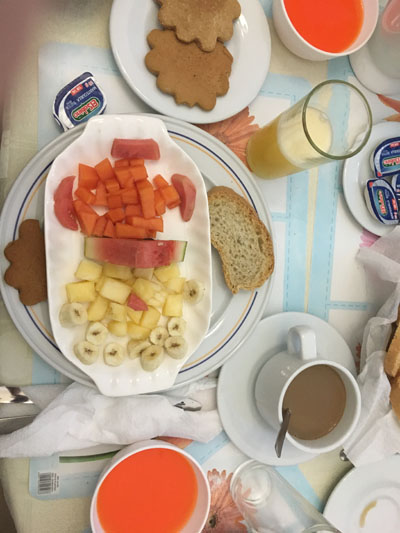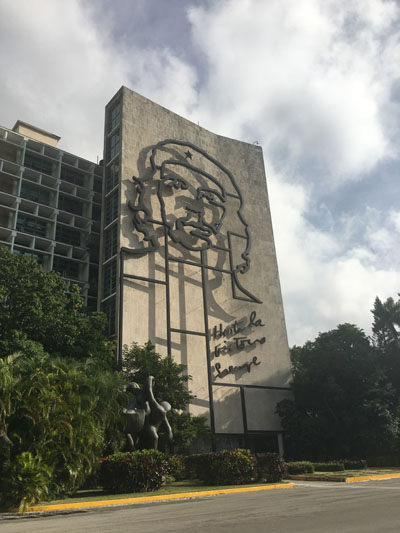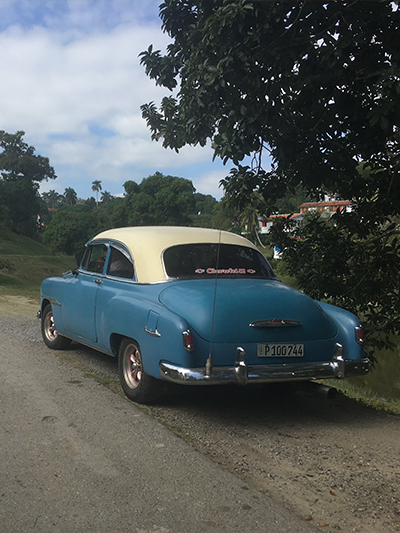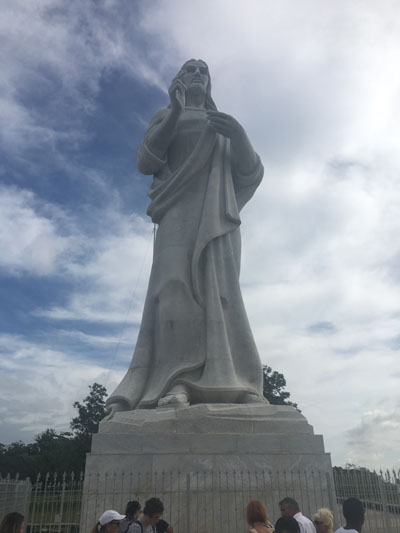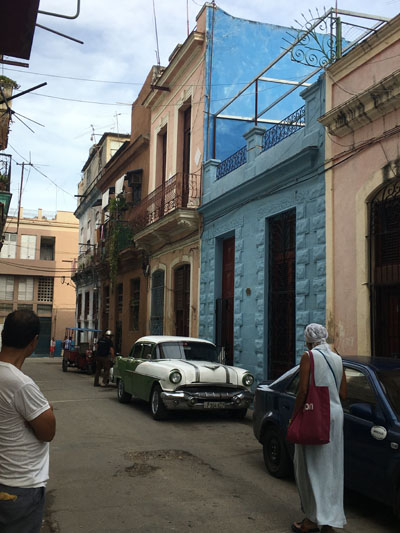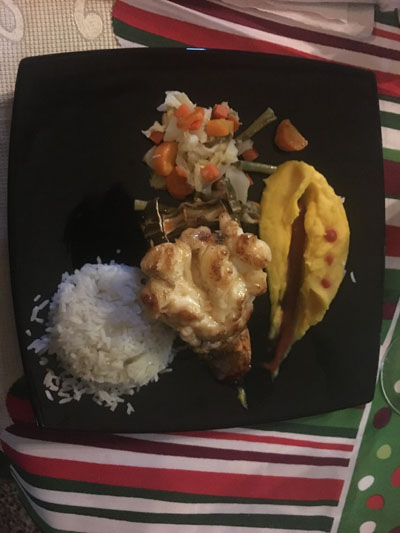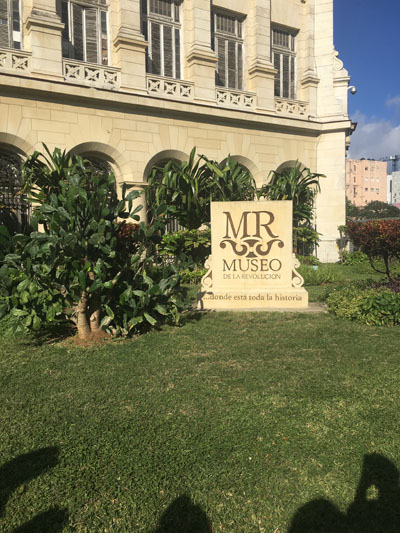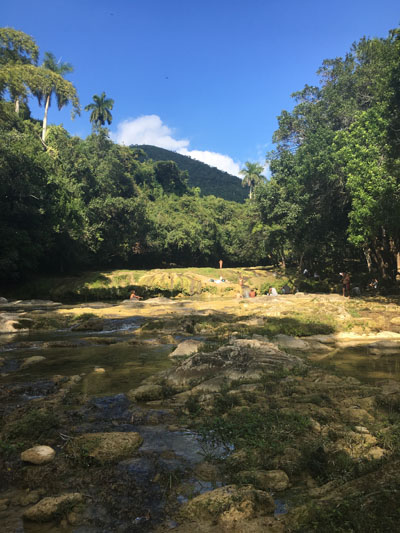Natalie Ray: Student Report from 2017 Alternative Winter Break in Cuba
“Viva Cuba!”
It was about thirteen degrees Fahrenheit outside as I boarded my flight on December 16th from Knoxville, Tennessee to Atlanta, Georgia where our group of nine would have a layover of about two and a half hours. Final destination? Havana, Cuba. I remember walking into the Dougherty Engineering building in early September and glancing at the bulletin board that was overflowing with all kinds of papers. Right there, in the middle of all the chaos, was a poster advertising an Alternative Winter Break trip to Cuba. I snapped a quick picture of the poster thinking I might look into it later. Little did I know in that moment, that I would actually end up on this trip. As our second plane of the day began its decent to José Martí International Airport in Havana, I could see coastline, palm trees, and farmland. I exited the plane to meet the rest of our group all the while shedding my extra layers of clothing to be more comfortable in the eighty-degree F, winter weather of the Caribbean. We gathered our luggage, exchanged some money, and hopped into taxis headed for the casa particular in Old Havana that we would call home during our weeklong stay. Sharing the road with classic cars from the 1950s, coconut taxis, yellow taxis, bicycle taxis, and even horse and buggies proved to be intimidating, but the drive offered our very first views of Havana and gave us a glimpse of what was to come in the following week.
“Welcome to Cuba! Spend your money.”
Being a foreigner in a country where you do not speak the language can be very intimidating. However, I must say that the Cuban people proved themselves to be some of the most welcoming, patient, and kind people with whom I have had the fortune of interacting. Our trip to Havana involved a lot of person-to-person interactions with those working at the casa particular, the people we worked with at the service project, tour guides, waiters, and many others. As a United States citizen, I expected some sort of disdain towards Americans, due to the embargo that has in a way kept Cuba stuck in the 1950s; however, this was not the case at all. Everybody I encountered was friendly and very excited to hear that I was an American. Since Americans have only been allowed in Cuba in recent years, the flux of tourists from the United States has benefited the Cuban economy greatly. As tourists, we did encounter a certain amount of banter from Cuban citizens on the street. Locals encouraging us to ride in their taxis, eat at their restaurants, and look in their stores were everywhere, but also incredibly respectful if we chose not to take them up on their offers.
“…donde está toda la historia.”
I must admit that before going to Cuba, I was not the most educated on Cuban history. Despite Cuba being located under 100 miles from the southern most tip of Florida, I knew surprisingly little about this Caribbean island. I did a small amount of research before I left and watched a documentary, but was left feeling mostly confused. The Revolution seemed complicated, and I did not fully understand why some Cuban citizens were happy about it while others were left devastated. Being in Havana, among the history, really helped in my understanding of it all. We took a trip to the Museum of the Revolution, and went on a walking tour of the city and took a classic car tour. All of these activities were very insightful, and I learned so much about Cuba’s history. The Museum of the Revolution was wonderful, and the sign at the front of the museum read “where all of the history is” in Spanish. I learned a lot about the Cuban Revolution of the late 1950s and the leaders of this movement, Fidel and Raul Castro and Ernesto “Che” Guevara. It was fascinating to learn about these things from the perspective of the Cuban people.
“Have a winter.”
As an English speaker in a Spanish speaking country, communication was limited. This was particularly evident when our group was working on our service project. Our project was in an area of Havana called Casa Blanca. This is a tourist destination on the eastern side of the port of Havana accessed by an underground tunnel for vehicles or a ferryboat for pedestrians on foot or bicycle. It is the site of the Cristo de Habana statue: a white marble statue sculpted by Cuban artist, Jilma Madera. It was beautiful, and the site of the statue provided an amazing view of the city of Havana. Our job in Casa Blanca was to wire kiosks for lighting, outlets, and switches. The schematic of the wiring was a simple circuit in series which I had just learned about in a physics class, so the wiring itself was relatively straightforward. Communicating exactly what was to be done was a different story, however. Hand gestures were found to be very helpful in achieving what we wanted to do, but the language barrier was never forgotten with the Spanish speaking workers saying silly things in English. One of the leaders of the project handed a large leaf to Mrs. Judith Mallory (our trip coordinator) to be used as a fan and said, “Have a winter.” Another worker at the site requested that we “Move the stairs” when referring to a ladder. Hearing these attempts at English was both funny and appreciated. Knowing that my Spanish was much worse than their English was very humbling and made me truly appreciate their efforts at communicating with us in English.
“Muy Bien.”
One thing that I always look forward to when travelling is trying new foods. Cuba did not disappoint in this regard. We were provided breakfast each morning by those working in the casa particular. This typically consisted of freshly squeezed juices, coffee, fruits, sandwiches, toast, and sometimes Jell-O or yogurt. It was a wonderful way to start each day in beautiful Havana. Other meals typically consisted of a meat (chicken, pork, or beef), rice and beans, yucca, vegetables, and potatoes, and the prices were surprisingly low. Some foods I got to try for the very first time. These foods included lamb, lobster, yucca, and plantains. I loved all of it. Many meals offered the option of a drink such as a mojito, a daiquiri, or a Cuba Libre all of which included the famous Havana Club Rum. I even tried a new dessert, flan, which was caramel-y and delicious, and the strong Cuban coffee lived up to its reputation when I tried espresso for the first time and felt my legs shaking from the caffeine. On one of our last nights in Havana, we were treated to a cooking class in our casa particular. They taught us how to prepare yucca (a root vegetable kind of like a potato), Ropa Vieja (shredded beef cooked in a marinade), and tostones (plantain chips). We then got to eat the tasty dinner that they had just taught us how to prepare. This is considered a very typical Cuban meal, so I returned home and made the meal for my family.
“Hasta la vista.”
By the time we left, I felt like I had really learned how to make my way around the area of Old Havana, and our excursion outside of the city to Las Terrazas was a welcome change to the hustle and bustle of the city. Its calming, rural setting was absolutely wonderful and the natural beauty of Cuba was evident here. Beautiful palm trees, calm waters, blue skies, and wildlife were plentiful. Overall, going to Cuba was an absolutely amazing experience. I learned so much about our nearby neighbors to the south, and gained an incredible appreciation for the Cuban culture. If one thing is for sure it is that this was an experience I will never forget, and I can only hope that I will one day return and experience once more the beautiful culture that I so quickly fell in love with.
